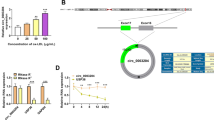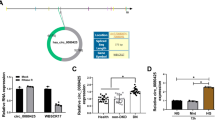Abstract
Endothelial dysfunction is a primary cause of diabetes-related vascular complications, such as atherosclerosis. Accumulated research indicates that circular RNAs (circRNAs) are involved in the pathogenesis of cardiovascular disease. This study intended to explore the function and mechanism of circBPTF in high glucose (HG)-induced vascular inflammatory models. Cell model of inflammatory injury was established in human umbilical vein endothelial cells (HUVECs) with HG treatment. The expression of circBPTF, miR-384 and lin-28 homolog B (LIN28B) was detected by quantitative real-time polymerase chain reaction (qRT-PCR). Cell viability and apoptosis were assessed by cell counting kit-8 (CCK-8) and flow cytometry assay, respectively. The expression of LIN28B was also examined using western blot. The release of proinflammatory cytokines was detected by enzyme-linked immunosorbent assay (ELISA). The production of ROS, SOD and MDA was detected to assess oxidative stress. The target relationship was predicted by bioinformatics analysis and verified using dual-luciferase reporter assay and RIP assay. CircBPTF was highly regulated in HG-induced HUVECs. CircBPTF knockdown increased cell viability and suppressed cell apoptosis, the release of proinflammatory cytokines and oxidative stress in HG-induced HUVECs. MiR-384 was targeted by circBPTF, and its downregulation abolished the effects of circBPTF knockdown. Moreover, circBPTF positively regulated LIN28B expression via targeting miR-384. Overall, CircBPTF knockdown protected against HG-induced inflammatory injuries and oxidative stress by mediating the miR-384/LIN28B axis in HUVECs. Our study provides a feasible theoretical strategy for preventing vascular cell dysfunction.







Similar content being viewed by others
References
Haring R, Wallaschofski H, Nauck M, Felix SB, Schmidt CO, Dorr M, Sauer S, Wilmking G, Volzke H (2010) Total and cardiovascular disease mortality predicted by metabolic syndrome is inferior relative to its components. Exp Clin Endocrinol Diabetes 118:685–691. https://doi.org/10.1055/s-0030-1261876
Patel H, Chen J, Das KC, Kavdia M (2013) Hyperglycemia induces differential change in oxidative stress at gene expression and functional levels in HUVEC and HMVEC. Cardiovasc Diabetol 12:142. https://doi.org/10.1186/1475-2840-12-142
Huang D, Refaat M, Mohammedi K, Jayyousi A, Al Suwaidi J, Abi Khalil C (2017) Macrovascular complications in patients with diabetes and prediabetes. Biomed Res Int 2017:7839101. https://doi.org/10.1155/2017/7839101
Hadi HA, Suwaidi JA (2007) Endothelial dysfunction in diabetes mellitus. Vasc Health Risk Manag 3:853–876
Versari D, Daghini E, Virdis A, Ghiadoni L, Taddei S (2009) Endothelial dysfunction as a target for prevention of cardiovascular disease. Diabetes Care 32(Suppl 2):S314–321. https://doi.org/10.2337/dc09-S330
Wang Q, Zhang M, Ding Y, Wang Q, Zhang W, Song P, Zou MH (2014) Activation of NAD(P)H oxidase by tryptophan-derived 3-hydroxykynurenine accelerates endothelial apoptosis and dysfunction in vivo. Circ Res 114:480–492. https://doi.org/10.1161/CIRCRESAHA.114.302113
Yan SF, Ramasamy R, Naka Y, Schmidt AM (2003) Glycation, inflammation, and RAGE: a scaffold for the macrovascular complications of diabetes and beyond. Circ Res 93:1159–1169. https://doi.org/10.1161/01.RES.0000103862.26506.3D
Kassab A, Piwowar A (2012) Cell oxidant stress delivery and cell dysfunction onset in type 2 diabetes. Biochimie 94:1837–1848. https://doi.org/10.1016/j.biochi.2012.01.020
Afanas'ev I (2010) Signaling of reactive oxygen and nitrogen species in Diabetes mellitus. Oxidative Med Cell Longev 3:361–373. https://doi.org/10.4161/oxim.3.6.14415
Cai H, Harrison DG (2000) Endothelial dysfunction in cardiovascular diseases: the role of oxidant stress. Circ Res 87:840–844. https://doi.org/10.1161/01.res.87.10.840
Jiang G, Ma Y, An T, Pan Y, Mo F, Zhao D, Liu Y, Miao JN, Gu YJ, Wang Y, Gao SH (2017) Relationships of circular RNA with diabetes and depression. Sci Rep 7:7285. https://doi.org/10.1038/s41598-017-07931-0
He M, Wang W, Yu H, Wang D, Cao D, Zeng Y, Wu Q, Zhong P, Cheng Z, Hu Y, Zhang L (2019) Comparison of expression profiling of circular RNAs in vitreous humour between diabetic retinopathy and non-diabetes mellitus patients. Acta Diabetol. https://doi.org/10.1007/s00592-019-01448-w
Ding S, Zhu Y, Liang Y, Huang H, Xu Y, Zhong C (2018) Circular RNAs in vascular functions and diseases. Adv Exp Med Biol 1087:287–297. https://doi.org/10.1007/978-981-13-1426-1_23
Ashwal-Fluss R, Meyer M, Pamudurti NR, Ivanov A, Bartok O, Hanan M, Evantal N, Memczak S, Rajewsky N, Kadener S (2014) circRNA biogenesis competes with pre-mRNA splicing. Mol Cell 56:55–66. https://doi.org/10.1016/j.molcel.2014.08.019
Guo JU, Agarwal V, Guo H, Bartel DP (2014) Expanded identification and characterization of mammalian circular RNAs. Genome Biol 15:409. https://doi.org/10.1186/s13059-014-0409-z
Memczak S, Jens M, Elefsinioti A, Torti F, Krueger J, Rybak A, Maier L, Mackowiak SD, Gregersen LH, Munschauer M, Loewer A, Ziebold U, Landthaler M, Kocks C, le Noble F, Rajewsky N (2013) Circular RNAs are a large class of animal RNAs with regulatory potency. Nature 495:333–338. https://doi.org/10.1038/nature11928
Chen J, Cui L, Yuan J, Zhang Y, Sang H (2017) Circular RNA WDR77 target FGF-2 to regulate vascular smooth muscle cells proliferation and migration by sponging miR-124. Biochem Biophys Res Commun 494:126–132. https://doi.org/10.1016/j.bbrc.2017.10.068
Fang Y, Wang X, Li W, Han J, Jin J, Su F, Zhang J, Huang W, Xiao F, Pan Q, Zou L (2018) Screening of circular RNAs and validation of circANKRD36 associated with inflammation in patients with type 2 diabetes mellitus. Int J Mol Med 42:1865–1874. https://doi.org/10.3892/ijmm.2018.3783
Jin G, Wang Q, Hu X, Li X, Pei X, Xu E, Li M (2019) Profiling and functional analysis of differentially expressed circular RNAs in high glucose-induced human umbilical vein endothelial cells. FEBS open bio 9:1640–1651. https://doi.org/10.1002/2211-5463.12709
Magenta A, Greco S, Gaetano C, Martelli F (2013) Oxidative stress and microRNAs in vascular diseases. Int J Mol Sci 14:17319–17346. https://doi.org/10.3390/ijms140917319
Sessa R, Seano G, di Blasio L, Gagliardi PA, Isella C, Medico E, Cotelli F, Bussolino F, Primo L (2012) The miR-126 regulates angiopoietin-1 signaling and vessel maturation by targeting p85beta. Biochem Biophys Acta 1823:1925–1935. https://doi.org/10.1016/j.bbamcr.2012.07.011
Small EM, Sutherland LB, Rajagopalan KN, Wang S, Olson EN (2010) MicroRNA-218 regulates vascular patterning by modulation of Slit-Robo signaling. Circ Res 107:1336–1344. https://doi.org/10.1161/CIRCRESAHA.110.227926
Xia F, Sun JJ, Jiang YQ, Li CF (2018) MicroRNA-384-3p inhibits retinal neovascularization through targeting hexokinase 2 in mice with diabetic retinopathy. J Cell Physiol 234:721–730. https://doi.org/10.1002/jcp.26871
Ma L, Zhao Q, Chen W, Zhang Y (2018) Oncogene Lin28B increases chemosensitivity of colon cancer cells in a let-7-independent manner. Oncol Lett 15:6975–6981. https://doi.org/10.3892/ol.2018.8250
Brennan E, Wang B, McClelland A, Mohan M, Marai M, Beuscart O, Derouiche S, Gray S, Pickering R, Tikellis C, de Gaetano M, Barry M, Belton O, Ali-Shah ST, Guiry P, Jandeleit-Dahm KAM, Cooper ME, Godson C, Kantharidis P (2017) Protective effect of let-7 miRNA family in regulating inflammation in diabetes-associated atherosclerosis. Diabetes 66:2266–2277. https://doi.org/10.2337/db16-1405
Zheng J, Liu X, Wang P, Xue Y, Ma J, Qu C, Liu Y (2016) CRNDE promotes malignant progression of glioma by Attenuating miR-384/PIWIL4/STAT3 Axis. Mol Therapy 24:1199–1215. https://doi.org/10.1038/mt.2016.71
Daiber A, Steven S, Weber A, Shuvaev VV, Muzykantov VR, Laher I, Li H, Lamas S, Munzel T (2017) Targeting vascular (endothelial) dysfunction. Br J Pharmacol 174:1591–1619. https://doi.org/10.1111/bph.13517
Magenta A, Cencioni C, Fasanaro P, Zaccagnini G, Greco S, Sarra-Ferraris G, Antonini A, Martelli F, Capogrossi MC (2011) miR-200c is upregulated by oxidative stress and induces endothelial cell apoptosis and senescence via ZEB1 inhibition. Cell Death Differ 18:1628–1639. https://doi.org/10.1038/cdd.2011.42
Karbach S, Croxford AL, Oelze M, Schuler R, Minwegen D, Wegner J, Koukes L, Yogev N, Nikolaev A, Reissig S, Ullmann A, Knorr M, Waldner M, Neurath MF, Li H, Wu Z, Brochhausen C, Scheller J, Rose-John S, Piotrowski C, Bechmann I, Radsak M, Wild P, Daiber A, von Stebut E, Wenzel P, Waisman A, Munzel T (2014) Interleukin 17 drives vascular inflammation, endothelial dysfunction, and arterial hypertension in psoriasis-like skin disease. Arterioscler Thromb Vasc Biol 34:2658–2668. https://doi.org/10.1161/ATVBAHA.114.304108
Lin H, Pan S, Meng L, Zhou C, Jiang C, Ji Z, Chi J, Guo H (2017) MicroRNA-384-mediated Herpud1 upregulation promotes angiotensin II-induced endothelial cell apoptosis. Biochem Biophys Res Commun 488:453–460. https://doi.org/10.1016/j.bbrc.2017.05.035
Duarte FV, Palmeira CM, Rolo AP (2015) The emerging role of MitomiRs in the pathophysiology of human disease. Adv Exp Med Biol 888:123–154. https://doi.org/10.1007/978-3-319-22671-2_8
Fu X, Ou B (2020) miR-152/LIN28B axis modulates high-glucose-induced angiogenesis in human retinal endothelial cells via VEGF signaling. J Cell Biochem 121:954–962. https://doi.org/10.1002/jcb.28978
Acknowledgement
None.
Funding
None.
Author information
Authors and Affiliations
Corresponding author
Ethics declarations
Conflict of interest
All authors declare that they have no conflict of interest.
Additional information
Publisher's Note
Springer Nature remains neutral with regard to jurisdictional claims in published maps and institutional affiliations.
Rights and permissions
About this article
Cite this article
Zhang, W., Sui, Y. CircBPTF knockdown ameliorates high glucose-induced inflammatory injuries and oxidative stress by targeting the miR-384/LIN28B axis in human umbilical vein endothelial cells. Mol Cell Biochem 471, 101–111 (2020). https://doi.org/10.1007/s11010-020-03770-2
Received:
Accepted:
Published:
Issue Date:
DOI: https://doi.org/10.1007/s11010-020-03770-2




